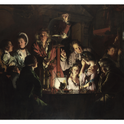Alfred Hitchcock (Madame Tussauds London)
© Artur Andrzej
Madame Tussauds is like a safari, only it’s celebrity you’re stalking, and about halfway through you begin to feel more hunted than hunter. You are, after all, the only thing moving, unless you count the eyes that flick mechanically back and forth on the French revolutionary waxwork. And the revolutionary is hidden many, many famous faces away—past Brangelina, past Harry and Wills, past JFK and MLK—in a far-off “zone” devoted to the place’s own history.
But it is precisely the institution’s history that has brought me here. On 1st December, to little fanfare, Madame Tussauds passed a milestone: the 250th birthday of its founder and namesake. Born Marie Grosholtz in 1761, she learned the art of waxworks from Philippe Curtius, a Swiss doctor, and went on to found an institution that has become a museum empire, its outposts strung across the world from Amsterdam to Washington DC and Shanghai to (of course) Las Vegas.
Marie Tussaud made her name during the tumultuous years before and after the French revolution. A quarter of a millennium on, the institution she founded may yet be scuppered by another populist cultural force, this time one she helped to create: the idea that celebrity status is within the grasp of us all. If celebrity can be had by everyone, why splash out more than £20 to get close to a waxen imitation?
A trip to London’s legendary house of wax used to begin with the queue that snakes around its copper-topped home. Now, you can pre-book online and step fast-track into a lift to be swept directly up to the “A-list” zone.
“Everyone step this way and just beyond the doors the stars are very eagerly waiting to meet you today,” promises a tired-looking staffer on the afternoon of my visit.
Inside, there is no natural light, just a high-wattage glare, enhanced by the dazzle of glitter balls and camera flashes. To my left, Bollywood stars smoulder, oblivious of one another, indulgent of a middle-aged woman in sari and woolly scarf who wanders among them, beaming beside each in turn. To my right, Robert Downey Jr brings anachronistically tousled hair to the role of Sherlock Holmes. Then it’s on past Drew Barrymore, Marilyn Monroe, and a neglected Audrey Hepburn. Sat in the middle of the room is Shrek, vast and green and a little confusing. (Isn’t the thrill of Tussauds meant to derive from how human these wax sculptures are?)
Visitors to Madame Tussauds wind their way through 14 low-ceilinged zones, passing world leaders, sports stars, cultural figures, and an awful lot of Coca-Cola dispensers. This journey through space and time culminates, of course, with the gift shop. There are also more unexpected elements—SCREAM, a dark maze where actors dressed as ghouls leap out to surprise you, and the Spirit of London ride, which whisks you through the city’s past in a dodgem-like taxi.
Each zone has its own soundscape—cacophonous loops pieced together from catchphrases and music clips and soundbites of such brevity that you’re condemned to hear each over and over again, making you feel like you’ve been traipsing round Tussauds forever. It takes about two hours to process from start to finish, but real time is meaningless here: the displays fold chronologies on one another like a game of consequences, leaving Oscar Wilde admiring Isaac Newton’s corkscrew wig, and Isambard Kingdom Brunel glancing uncertainly at Einstein’s baggy pullover.
Every reigning British monarch since George III has sat for Tussauds, but its real clout rests in a sustained ability to crown celebrities as stars. The inherent impermanence of the medium—compare a waxwork to a brass star embedded in the Hollywood Walk of Fame, say—only enhances its appeal, making it one with the unstable merry-go-round of celebrity itself. Who knows how long each figure’s moment will last, but it’s a moment to be celebrated, and no matter how crowded their trophy cabinets, stars almost always show up to pose beside their newly completed wax doppelgangers. They aren’t the only ones. At Tussauds today, there is strikingly little looking and an awful lot of posturing for cameras, phones, even the obligatory iPad. Whereas in Marie’s day waxworks made celebrity and history real and relatable, Tussauds now makes the real fake by removing the red ropes around the exhibits and allowing visitors to pose with their arm around Rihanna or reshoot their smooch with Marilyn.
In another zone, a teenager wearing Justin Bieber-ish threads and an air of sleepy puzzlement is pointing to a waxwork of Andy Warhol. “Who’s that?” he asks. The kid is American but Tussauds attendants must hear the same question mumbled many times a day in multiple languages. Fame is fickle. None had a keener sense of this than the woman whose name lives on as the imprimatur of celebrity. Long before Warhol weighed in with his 15 minutes, Marie Tussaud helped to mould celebrity culture as we know it. The story of her life and career laid the foundations for Tussauds today, from its judgement-free insistence that notoriety is equal to celebrity in the fame stakes (you want to pose with your arm around Adolf Hitler? Sure!) to the relentless pace it sets for novelty and its tabloid devotion to giving the public precisely what they want.
Search hard enough through the labyrinth of Madame Tussauds and you will eventually find Marie herself. A slight, round-shouldered woman covered in black crêpe, she has fine hands and a face framed by a lace-trimmed bonnet. Oval spectacles obscure her eyes, but her mouth is expressive. Of what exactly, it’s hard to decide.
Tussaud’s life story is more interesting than many of her starrier waxen cohorts. She had a flair for fabulation, as her memoirs attest—full of romanticised, and probably false, claims about her origins and life. Although she insisted her father died before she was born, biographers have concluded that Tussaud was most likely the daughter of her mother’s employer, Philippe Curtius. Like many medics of the time, Curtius made anatomical waxes, but his were exceptionally skilful, especially when it came to replicating the textures and hues of living human skin. Louis XV’s cousin, the Prince de Conti, was so impressed that he offered Curtius patronage, and thus six-year-old Marie found herself transplanted to Paris. As she grew up, Curtius inducted Marie into his art. She had talent, and at 17 created her first wax figure: Jean-Jacques Rousseau. She followed it with Voltaire and Benjamin Franklin. She liked to say that all three were frequent dinner guests at Curtius’s table, and that Rousseau enjoyed her mother’s cooking.
By the early 1780s, having proven their commercial viability at fairs, Curtius’s waxworks could be seen in permanent venues at two of Paris’s entertainment hotspots: the Palais Royal and the Boulevard du Temple. The first of these offered the ritzier experience, billing itself as a “salon” and arranging models of creative luminaries like Voltaire and rulers such as Frederick the Great to allow visitors to feel they were mingling in aristocratic company. A tiered pricing system at the ticket gate meant that only a privileged few could afford to breach the red rope. At the Boulevard du Temple, meanwhile, the public could experience something more akin to today’s Chamber of Horrors. Here were not only heroes but villains too. Murderers and thieves were bathed in a blue light, and fake blood liberally applied.
As Tussaud biographer Kate Berridge notes in Waxing Mythical, the figures collectively provided “an illustrated supplement to the news of the day,” and come the revolution, Marie and Curtius were well placed to capitalise on its twists and turns. The pace with which their cast of waxworks changed was set by the relentless downward swoosh of the guillotine. Today, it takes a team of 20 people four months to make a model. A pair of eyes takes ten hours to make and hair six weeks to be woven in, bringing the price tag on London’s newest arrival, Kate Winslet, to £150,000. Curtius and Marie made their figures in days.
By the dawn of the 19th century, Marie was unhappily married to the engineer François Tussaud, the mother of two small boys, and the proprietor of the ailing business she had inherited from Curtius. In 1802, having just turned 40, she took advantage of a lull in the Napoleonic war and crossed the Channel. She spoke no English and travelled with her elder son, aged four, in tow. She would never again return to France and did not see her younger child again until he was 21.
“This tiny woman possessed self-reliance, courage and determination to an unusual degree. She was tough, exceptionally well-organised and paid fanatical attention to detail, particularly in matters financial,” writes Pamela Pilbeam in Madame Tussaud and the History of Waxworks. Madame even operated the cash desk herself, we’re told.
Until 1808, she continued to tour her show across Britain as “Curtius’s Cabinet of Curiosities” while reinventing herself as a royalist who had moved in exalted circles—living at Versailles and working as art tutor to Louis XVI’s sister, no less—and who had escaped the revolution. Her new persona enabled her to ditch déclassé elements of the traditional waxwork show—the sideshow freaks and anatomical ladies—and reach a smarter crowd. In Paris, even the Palais Royal had been a magnet for working girls and hustlers. Now, aside from a few royal mistresses, there were no filles de joie to be found at Madame’s establishment. This was entertainment for the family, promised promotional material, and an upscale family at that. One of her early British coups was a commission from the jilted and childless Duchess of York, who poignantly requested a model of a little boy.
Tussaud continued to tour into her seventies, but by 1835, the exhibition had acquired a permanent home on Baker Street, right around the corner from its Marylebone Road address of the past 127 years. She made her last model, a self-portrait, at the age of 81, and died in 1850.
***
In many ways Madame Tussauds still resembles the institution Marie founded. One of the tricks she picked up from Curtius was the constant updating of her exhibition according to public tastes, and visitor polls remain crucial in determining additions to a cast of waxworks, whose turnover continues to be brisk. As far back as the Victorian era, Tussauds’ management could divide its figures into “immortals” (Robert Baden-Powell) and “ephemerals” (Serbian royals). Fame may seem fleeting in the age of reality TV—perhaps not fleeting enough in some instances—but it has ever been thus.
Nevertheless, the Tussauds of today is strewn with reminders that “immortals” are endangered. The Pope, the Dalai Lama, Nelson Mandela, Gandhi and Archbishop Desmond Tutu huddle humbly against a backdrop of wheeling doves, careful not to disrupt foot traffic passing from the Music Zone to the Chamber of Horrors. Part of the appeal of waxwork exhibits is the way they jumble history and geography, bringing together characters who likely never met. But the disorder of these displays strips history of its narrative and meaning. Meanwhile, there’s Tiger Woods, ingloriously positioned opposite a fudge stand, looking presciently aware of his fall from grace.
It’s hard not to feel that when you’re allowed this close to celebrity, it loses its meaning. Steven Spielberg rocks a little when a visitor’s Harrods-bag-toting arm is slung chummily around his shoulders for yet another photograph. You can get close enough to Jesse Owens to see that the skin colour on his thigh has chipped through to the undercoat.
And that’s where the real change has occurred since Marie Tussaud’s day: in the way we consume celebrity. In the 18th and 19th century the models were ringed off by red ropes. Now that they’ve been removed, we can all mingle with the great and the good. The word “celebrity” is no longer restricted to an elite circle of the rich and glamorous. With fame comes celebrity, and there have never been more ways for ordinary folk to become famous—whether through reality TV or internet channels like YouTube or Twitter. Tech marketing guru David Weinberger has rephrased Warhol’s maxim for our world of social networking: “In the future, everyone will be famous for 15 people.”
As the bar to becoming a celebrity drops ever lower, one might expect a tourist attraction that brings us closer to the famous would become less popular. Yet, paradoxically, this has made the pull of Madame Tussauds stronger not weaker. The Queen, Michael Jackson and Prince William (the most kissed waxwork of 2010) may be the most posed-with and photographed exhibits, but in general the identity of any given waxwork seems less important than simple proximity to celebrity. These pictures are about the poser, not the star.
By posing with celebrities and walking on the red carpet, visitors are invited to play out their fantasies—they become celebrities, if only for an afternoon. Throughout, light is cast by chandeliers, except for a particularly gloomy corner in which Mohamed Al-Fayed stands bathed in the glow of a popcorn dispenser. Naturally, the merchandise plays to this faux-glamour, too, plastic Oscars being just the beginning.
The decision to cast the tourist as equal to the stars—remember, it’s they who can’t wait to meet you—is an extension of the aspirational tenor that has been part of the Tussauds experience from the start, borrowed from Curtius’s Palais Royal “salon” that allowed the moneyed to hobnob with the rich and powerful. Nowadays, the democratisation of celebrity lets us all through.
It is that adaptability to the culture at large that has made Tussauds such a global success. In 2007, The Tussauds Group was acquired for £1bn by Merlin Entertainments, and still it grows, with the red carpet to be rolled out at a Sydney branch next year, and in Florida in 2013. Two hundred and fifty years after Marie Tussaud’s birth, her legacy, oddly, endures. There is still no place quite like Tussauds for understanding celebrity, and sometimes, those faces are more eloquent than wax has a right to be. In the case of Charlie Chaplin, who is to be found skulking in the shop opposite a tower of mugs, his pensive visage suggests that celebrity isn’t all it’s cracked up to be.













